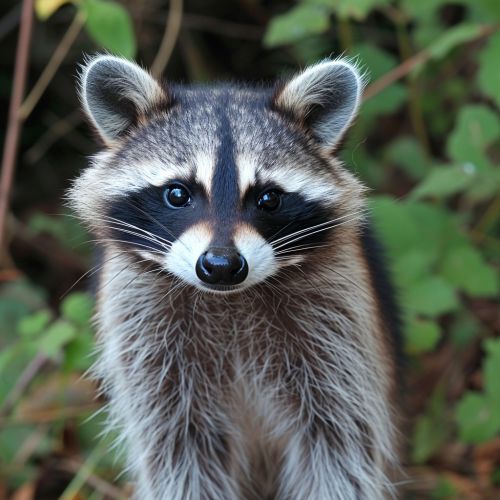The Raccoons
Taxonomy and Evolution
The raccoon, or Procyon lotor, belongs to the Procyonidae family, which also includes coatis, kinkajous, olingos, ringtails, and cacomistles. The genus Procyon, derived from the Greek words "pro" (before) and "kyon" (dog), was first described by the French zoologist Mathurin Jacques Brisson in 1762. The species name lotor is Latin for "washer", referencing the raccoon's well-known habit of dipping its food in water before eating.
Raccoons are believed to have evolved in North America, where the oldest fossils, dating from the late Miocene epoch, have been found. Over time, raccoons migrated to Central and South America, where they adapted to various habitats. The raccoon's adaptable nature and omnivorous diet have played a significant role in its successful evolution.

Physical Characteristics
Raccoons are medium-sized mammals, typically weighing between 5 and 26 kg (11 and 57 lb). They have a body length of 40 to 70 cm (16 to 28 in) and a tail length of 20 to 40 cm (8 to 16 in). Their fur is thick and insulating, with a coloration that ranges from grey to reddish brown, and a distinctive black "mask" over the eyes.
One of the raccoon's most notable features is its highly sensitive front paws, which contain a high concentration of nerve endings. This sensitivity allows raccoons to identify objects before touching them, a trait known as somatosensation. Raccoons are also known for their dexterous paws, which they use to manipulate and examine objects.
Behavior and Ecology
Raccoons are nocturnal animals, most active during the night. They are solitary creatures, with males having a range of 3 to 20 square kilometers, while females cover about half that area. During the winter, raccoons in colder climates can sleep for extended periods, although they do not truly hibernate.
Raccoons are omnivores, with a diet that includes fruits, plants, insects, rodents, frogs, and bird eggs. In urban areas, they are known to rummage through garbage for food. Raccoons have few natural predators, with the main threats being cougars, bobcats, and coyotes. In urban areas, they are often killed by cars or through human intervention.
Reproduction and Lifespan
Raccoons typically mate between January and March, with a gestation period of about 65 days. Females, known as sows, give birth to one to seven cubs each year. The cubs are born blind and deaf, but their senses develop within a few weeks. They are weaned at about 16 weeks and reach sexual maturity at about one year.
The average lifespan of a raccoon in the wild is two to three years, although some have been known to live up to 20 years in captivity. The most common causes of death are hunting, vehicular accidents, and diseases such as rabies and distemper.
Raccoons and Humans
Raccoons have a complex relationship with humans. On one hand, they are often viewed as pests due to their habit of rummaging through garbage and their potential to transmit diseases like rabies. On the other hand, their intelligence and dexterity have made them popular in some forms of entertainment and as pets, although keeping raccoons as pets is illegal in many areas due to the potential health risks.
In some cultures, raccoons are featured in folklore and mythology. For example, in Native American mythology, the raccoon is often portrayed as a trickster figure due to its clever and mischievous nature.
Conservation Status
The raccoon is listed as a species of least concern by the International Union for Conservation of Nature (IUCN) due to its wide distribution and large population. However, in some areas, raccoon populations have been impacted by hunting, habitat loss, and disease. Efforts to manage and conserve raccoon populations are ongoing, particularly in areas where they are considered a nuisance or threat to public health.
